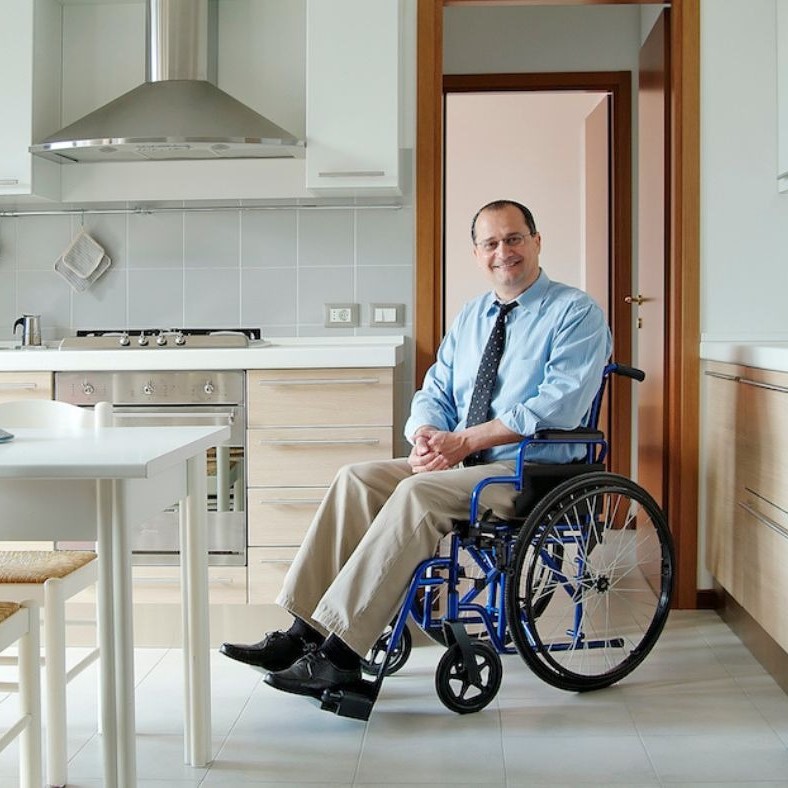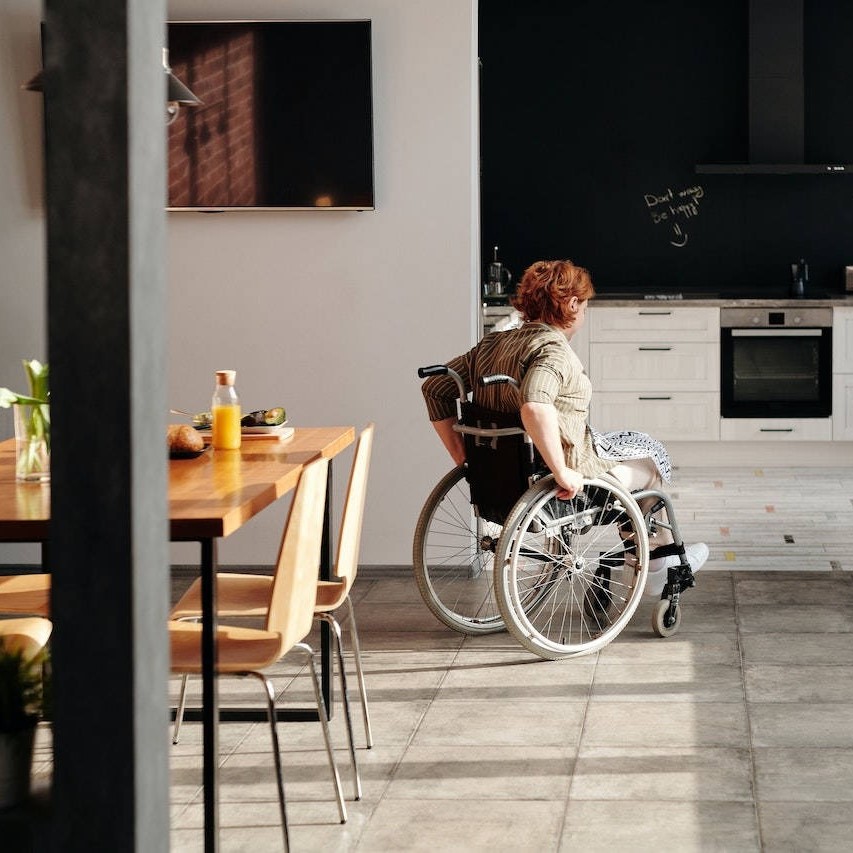The Importance of Adequate Doorway Width for Wheelchair Access
Ensuring adequate [doorway width for wheelchair] access is crucial for inclusivity and independence. A doorway that is too narrow can restrict a wheelchair user’s ability to enter and navigate through buildings comfortably. It affects their ability to visit friends, engage in social activities, and access services.
Adequate doorway width allows for safe passage without the risk of injury or the need to perform tricky maneuvers. This is not just a matter of convenience but also of safety and dignity. A wide enough entrance facilitates smooth access for wheelchairs, and it also benefits people with walkers, parents with strollers, and individuals carrying bulky items.
Additionally, proper doorway width ensures that buildings are accessible to all, in compliance with legal standards and promoting an environment of equality. It plays a key part in making public and private spaces friendly for everyone, demonstrating an organization’s or homeowner’s commitment to accessibility.
By providing enough space for wheelchairs to pass through, we create an inclusive society where all individuals, regardless of their mobility challenges, feel welcomed and valued. The topic of doorway width is not just about adhering to regulations but is deeply connected to the quality of life for many people.
ADA Compliance: Understanding the Minimum Width Requirements
The Americans with Disabilities Act (ADA) sets the benchmark for [doorway width for wheelchair] specifications. These regulations stipulate that doorways must be at least 32 inches wide when the door is open at 90 degrees. This width provides enough space for most wheelchairs to pass through comfortably. It is a legal requirement for public buildings and is often applied in residential construction as well.
Builders and architects must factor in the ADA’s minimum width when designing doorways. Ensuring ADA compliance is not just about legality but also about facilitating accessibility for wheelchair users. Every inch counts, as anything below the minimum can make navigation challenging and unsafe.
Measuring the doorway width seems straightforward, yet it requires precision. The width measurement must consider door hardware and any door-mounted equipment that could reduce the clear passable width. The ADA standards aim to eliminate barriers and enable smooth mobility for individuals who depend on wheelchairs for movement.
Strict adherence to ADA guidelines is essential. Non-compliance can result in legal action, penalties, or costly renovations. More importantly, failing to meet ADA standards can exclude a significant part of the population, preventing wheelchair users from accessing certain areas. By understanding and implementing the minimum doorway width requirements, we make a considerable step towards an inclusive and welcoming environment for all.
Measuring Doorways for Wheelchair Accessibility

When assessing doorway width for wheelchair access, accuracy is everything. To measure doorways correctly, you need a tape measure and a keen eye for detail. Begin by measuring the clear width of the door opening. This means measuring the space from the inside of one door jamb to the inside of the other, with the door open at a 90-degree angle.
Many people forget to account for the space the door itself takes up when open. Remember to measure from the face of the door to the opposite jamb when it’s open, as this can reduce the actual passage width. Also, be aware of any door hardware like handles or push plates that might intrude into the wheelchair clearance space.
Another aspect to consider is the threshold. Wheelchair users need a smooth transition, so thresholds should not be overly high or obstructive. Measure the threshold height and ensure it complies with ADA requirements, which favor a flush transition to avoid tripping hazards or wheelchair tipping.
If you are in a retrofitting scenario, your measurements will dictate the necessary modifications. Sometimes, you might find that the existing structure does not meet the ADA doorway width for wheelchairs. In such cases, precise measurements will guide you in creating a plan to widen doorways and ensure compliance.
Remember, ensuring proper doorway dimensions is an act of respect and inclusivity. By thoroughly measuring and, if needed, adjusting doorway widths, you make spaces more accessible and welcoming to wheelchair users.
Common Challenges in Meeting Doorway Width Standards
Meeting doorway width standards for wheelchair access often presents several challenges. One common issue is the presence of older buildings. These structures frequently have narrower doorways. They were constructed before the ADA regulations became a critical part of building design.
Another significant challenge is the cost of remodeling. Widening doorways to meet ADA compliance can be expensive. The process may require structural modifications, which increases expenses.
Sometimes, the design of the building itself poses constraints. Architectural features or load-bearing walls limit the possibilities for expansion. Such barriers make it difficult to adjust the doorway width without extensive work.
In residential settings, homeowners might lack awareness about the importance of doorway width for wheelchair access. They might not realize the impact narrow doorways have on the mobility of wheelchair users.
Lastly, compliance enforcement can be inconsistent. Not all buildings are regularly checked for ADA adherence. This can lead to a lack of urgency in making necessary changes to improve accessibility.
Despite these challenges, it’s crucial to strive for doorways that accommodate wheelchairs. This not only ensures legal compliance but also upholds the dignity and independence of wheelchair users.
Solutions for Narrow Doorways: Retrofitting and Remodeling Tips

When facing narrow doorways, a few solutions can help achieve the necessary [doorway width for wheelchair] access. Retrofitting or remodeling requires planning and can be made more manageable with the following tips.
- Assess and Plan: Review which doorways do not meet the proper width. Plan for the extent of changes needed.
- Consult Professionals: Talk to an architect or contractor who understands ADA guidelines and can offer practical solutions.
- Consider Door Alterations: Sometimes, replacing doors with wider ones or doors that swing outwards can maximize space.
- Explore Structural Modifications: If door expansion is needed, identify which walls are non-load bearing and can be adjusted.
- Use Offset Hinges: To gain extra inches, offset hinges allow doors to open wider, creating more room.
- Lower the Threshold: Ensure the threshold is ADA-compliant and does not hinder wheelchair access when doors are modified.
- Opt for Pocket Doors: If space allows, switching to pocket doors removes swing space issues altogether.
- Budget Accordingly: Recognize the cost implications and budget for the modifications without compromising safety and usability.
By applying these retrofitting and remodeling tips, doorways can better accommodate wheelchairs, fostering inclusivity in any environment. Remember, each change you make is a step forward in creating accessible spaces for all.
The Role of Building Codes in Wheelchair Accessible Design
Building codes play a vital role in ensuring that wheelchair accessible design is up to standard. These codes outline specific requirements for components like doorway width for wheelchair access, ensuring a smooth and safe environment for all users. They serve as a benchmark for architects, builders, and inspectors, setting out clear guidelines for construction and modification of buildings to meet the needs of wheelchair users.
Comprehensive building codes consider a range of factors, including the allowance for door swing, the space needed for maneuvering, and the necessary clearance for wheelchairs to pass through without hindrance. They also address other aspects such as ramp gradients, elevator dimensions, and bathroom configurations, all of which are vital for full accessibility.
To create truly accessible spaces, adherence to these codes is crucial. They must be applied during the initial design phase and also be checked throughout the construction process. In many regions, building codes are regularly updated to reflect new technologies and insights into accessible design practices.
Builders and designers are encouraged to not just meet the minimum standards but to strive for even greater accessibility. This approach empowers individuals with mobility impairments and has a positive impact on a wider segment of the community including those with temporary injuries, parents with strollers, and the elderly.
The role of building codes is not just about facilitating access; it’s about endorsing respect and equality for everyone in society. Ignoring these codes can lead to significant barriers for wheelchair users, thereby contributing to exclusion from everyday activities and public life.
In essence, building codes are more than just rules—they embody a commitment to inclusive and thoughtful design that benefits everyone. By following these guidelines, we can ensure that our communities remain accessible, welcoming, and compliant with legal accessibility standards.
Doorway Width Considerations for Different Types of Buildings

When addressing [doorway width for wheelchair] access, different types of buildings present unique challenges and requirements. These considerations are vital for ensuring that all structures, from residential homes to commercial facilities, are truly accessible.
- Residential Buildings: In homes, doorways should enable easy access to all rooms. Clear width should accommodate personal wheelchairs which can vary in size.
- Educational Facilities: Schools and universities should allow for larger wheelchairs typically used by children and adults. Extra width accommodates traffic during class changes.
- Healthcare Establishments: Hospitals and clinics need wider doorways for moving patients on gurneys or in larger, motorized wheelchairs.
- Office Buildings: Office spaces must consider wheelchair access in doorways, as well as space for maneuvering in work areas and conference rooms.
- Retail and Dining Spaces: Shops and restaurants should ensure doorways allow for wheelchair access along with flow of customer foot traffic.
- Historic Landmarks: These may have exemptions but still require creative solutions for accessibility without altering their historic character significantly.
Each type of building has distinct demands when it comes to doorway width. By paying attention to these needs and planning accordingly, we support an inclusive environment for wheelchair users. Designers and builders must be diligent in applying these standards to not only meet legal requirements but also to ensure equal access for all members of society.
Essential Tips for Ensuring Accessible Pathways in Homes and Public Spaces
Creating accessible pathways in homes and public spaces is crucial for wheelchair users. To ensure ease of access, consider the following tips:
- Broaden Doorways: Where possible, widen doorways beyond the ADA minimum of 32 inches, especially in areas of frequent passage or where people gather.
- Minimize Thresholds: Ramps or flush transitions can replace high thresholds to aid wheelchair users. Avoid abrupt changes in flooring levels.
- Install Handrails: Adding handrails can greatly assist in navigation, particularly in corridors or where elevation changes.
- Keep Pathways Clear: Remove any obstructions, such as furniture or rugs, that could impede a wheelchair’s movement or pose a trip hazard.
- Highlight Changes in Levels: Use contrasting colors or textures to clearly signal step edges or changes in floor level.
- Ensure Good Lighting: A well-lit path is essential for safety. Install lighting to illuminate doorways and walkways adequately.
- Plan for Turns and Rest Areas: Ensure there is enough room for wheelchairs to make turns. Consider space for resting if the pathway is long.
By following these essential tips, you can make homes and public spaces more welcoming and accessible for everyone.

